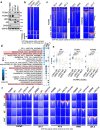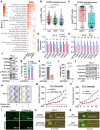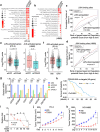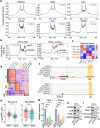FOXA2 rewires AP-1 for transcriptional reprogramming and lineage plasticity in prostate cancer
- PMID: 38851846
- PMCID: PMC11162502
- DOI: 10.1038/s41467-024-49234-9
FOXA2 rewires AP-1 for transcriptional reprogramming and lineage plasticity in prostate cancer
Abstract
FOXA family proteins act as pioneer factors by remodeling compact chromatin structures. FOXA1 is crucial for the chromatin binding of the androgen receptor (AR) in both normal prostate epithelial cells and the luminal subtype of prostate cancer (PCa). Recent studies have highlighted the emergence of FOXA2 as an adaptive response to AR signaling inhibition treatments. However, the role of the FOXA1 to FOXA2 transition in regulating cancer lineage plasticity remains unclear. Our study demonstrates that FOXA2 binds to distinct classes of developmental enhancers in multiple AR-independent PCa subtypes, with its binding depending on LSD1. Moreover, we reveal that FOXA2 collaborates with JUN at chromatin and promotes transcriptional reprogramming of AP-1 in lineage-plastic cancer cells, thereby facilitating cell state transitions to multiple lineages. Overall, our findings underscore the pivotal role of FOXA2 as a pan-plasticity driver that rewires AP-1 to induce the differential transcriptional reprogramming necessary for cancer cell lineage plasticity.
© 2024. The Author(s).
Conflict of interest statement
G.P.R, R.A.T. and M.G.L. have research collaborations with AstraZeneca, Pfizer. The remaining authors declare no competing interests.
Figures









References
MeSH terms
Substances
Grants and funding
- R01 CA211350/CA/NCI NIH HHS/United States
- W81XWH-21-1-0267/United States Department of Defense | United States Army | Army Medical Command | Congressionally Directed Medical Research Programs (CDMRP)
- U54CA156734/U.S. Department of Health & Human Services | NIH | National Cancer Institute (NCI)
- MCRF15023/Department of Health, State Government of Victoria (Victorian Department of Health)
- 159567/Gouvernement du Canada | Instituts de Recherche en Santé du Canada | CIHR Skin Research Training Centre (Skin Research Training Centre)
- MNBCF-17-012/Movember Foundation (Movember)
- W81XWH-19-1-0777/United States Department of Defense | United States Army | Army Medical Command | Congressionally Directed Medical Research Programs (CDMRP)
- MCRF18017/Department of Health and Human Services, State Government of Victoria (Department of Health and Human Services)
- 142246/Gouvernement du Canada | Instituts de Recherche en Santé du Canada | CIHR Skin Research Training Centre (Skin Research Training Centre)
- U54 CA156734/CA/NCI NIH HHS/United States
- R01CA211350/U.S. Department of Health & Human Services | NIH | National Cancer Institute (NCI)
- W81XWH-19-1-0361/United States Department of Defense | United States Army | Army Medical Command | Congressionally Directed Medical Research Programs (CDMRP)
LinkOut - more resources
Full Text Sources
Medical
Molecular Biology Databases
Research Materials
Miscellaneous

